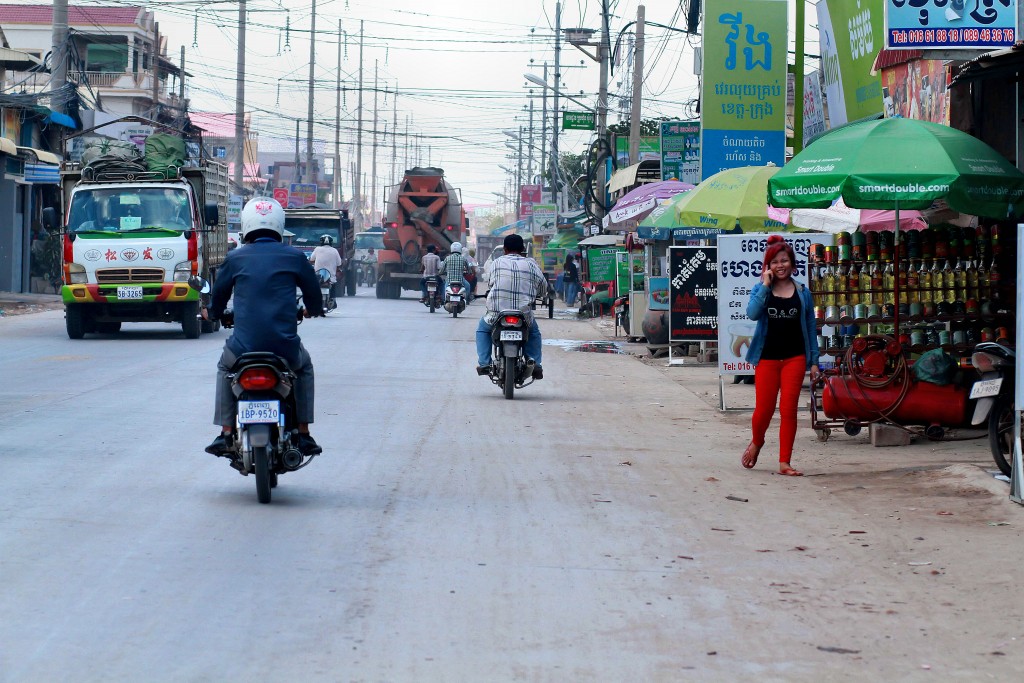
ឡានដឹកទំនិញធនធ្ងន់នៅលើកំណាត់ផ្លូវមួយនៃរាជធានីភ្នំពេញ ប្រទេសកម្ពុជា។ រូបភាព ថតដោយ Phalinn Ool កាលនៅថ្ងៃទី១៥ ខែមិថុនា ឆ្នាំ២០០៥។ ក្រោមអាជ្ញាប័ណ្ណ CC BY-NC-ND 2.0
អគ្គនាយកដ្ឋានពន្ធដារ បានរាយការណ៍ពីចំណូលពន្ធនា ៩០០លានដុល្លារអាមេរិក នៅឆ្នាំ២០១៣ និង ១.០៦ប៊ីលានដុល្លារអាមេរិក នៅឆ្នាំ២០១៤ ដែលមានកំណើន ១៧.៧ ភាគរយ។1 លើសពីនេះ សម្រាប់រយៈពេល ៩ខែដំបូង នៃឆ្នាំ២០១៥នេះ ចំណូនពន្ធដារ ត្រូវបានរាយការណ៍ថា នឹងស្ទុះឡើងប្រមាណជា ២៥ភាគរយ បើធៀបនឹងរយៈពេល ដូចគ្នាកាលពីឆ្នាំមុន ឬប្រហែលជា ១ប៊ីលានដុល្លារអាមេរិក។2 តួលេខខាងលើនេះ បង្ហាញ ច្បាស់ថា ពន្ធដារ គឺជាប្រភពមួយដ៏សំខាន់នៃចំណូល និងថវិកាជាតិរបស់រាជរដ្ឋាភិបាល។3
ទោះជាយ៉ាងណា ក្រសួងសេដ្ឋកិច្ច និងហិរញ្ញវត្ថុ នៅតែអាចប្រមូលពន្ធច្រើនជាងនេះ ប្រសិនបើការអនុវត្តច្បាប់ស្តីពីពន្ធដារ4 ត្រូវបានរឹតបន្តឹង។ នៅឆ្នាំ២០១៥ សហគ្រាសធន តូចស្ទើរតែទាំងអស់ ដែលជាប្រភពដ៏មានសក្តានុពលនៃចំណូលពន្ធដារ សម្រាប់ អគ្គនាយកដ្ឋានពន្ធដារ ត្រូវបានរាយការណ៍ថា ពុំមានធ្វើការចុះបញ្ជី។5 លើពីនេះ ក្រុមហ៊ុនខ្លះត្រូវបានរាយការណ៍ដោយក្រសួងថា ជំពាក់បំណុលពន្ធលើសលប់ ហើយដែលការយឺតយ៉ាងរបស់ក្រុមហ៊ុនទាំងនោះក្នុងការទូទាត់ពន្ធ នាំឱ្យមានការធ្លាក់ចុះខាងចំណូលពន្ធដារ និងថវិកាជាតិ។6
បន្ថែមពីលើនេះ រាជរដ្ឋាភិបាលអាចបង្កើនចំណូលពន្ធដារសម្រាប់ថវិកាជាតិ ដោយសម្រួលបែបបទនៃការបង់ពន្ធ និង ការបង្កើតវិធានច្បាប់បន្ថែម។ នាពេលថ្មីៗនេះ ការផ្តល់អាជ្ញាប័ណ្ណដល់ធនាគារអេស៊ីលីដា និងធនាគារកាណាឌីយ៉ា ក្នុងការប្រមូលពន្ធ បានចូលរួមចំណែកដល់ការរីកធំធាត់ជាបន្តបន្ទាត់លើចំណូលពន្ធដារពីមួយឆ្នាំ ទៅមួយឆ្នាំ។7 ជាមួយគ្នានេះ នៅក្នុងអំឡុងពេលពិនិត្យទូទាយ់ថវិកាជាតិឆ្នាំ២០១៣ ក្រសួងសេដ្ឋកិច្ច និងហិរញ្ញវត្ថុ បានបង្ហើបឱ្យដឹងថា កង្វះខាតវិធានច្បាប់គ្រប់គ្រងនៅក្នុងវិស័យធនធានធម្មជាតិ កាស៊ីណូ8 និងសារទូរគមនាគមន៍ គឺជាជាឧបសគ្គចម្បងដល់កិច្ចខិតខំប្រឹងប្រែងរបស់ក្រសួង នៅក្នុងការប្រមូលពន្ធពីឧស្សាហកម្មទាំងអស់នេះ ឱ្យបានច្រើន។9
គណៈរដ្ឋមន្ត្រី ដែលជាអង្គនីតិប្រតិបត្តិ អាចផ្តួចផ្តើមសេចក្តីព្រាងច្បាប់ថវិកាជាតិ ខណៈដែលរដ្ឋសភា ផ្តល់ការអនុម័តលើការបង្កើត កែប្រែ និងលុបចោល គ្រប់ពន្ធទាំងអស់។10 បើទោះជាច្បាប់ស្តីពីពន្ធដារ បានកំណត់លំដាប់នៃផលចំណេញ និងប្រាក់បៀវត្សរ៍ជាប់ពន្ធ យន្តការនេះក៏អាចធ្វើបានតាមរយៈច្បាប់ថវិកាផងដែរ ដោយធ្វើវិសោធនកម្មច្បាប់ពន្ធដារ។ ឧទាហរណ៍ ច្បាប់ថវិកាឆ្នាំ២០១៥ ចែងអំពីលំដាប់នៃប្រាក់បៀវត្សរ៍ជាប់ពន្ធ ដោយធ្វើវិសោធនកម្មមាត្រា ៤៧ នៃច្បាប់ស្តីពីពន្ធដារឆ្នាំ១៩៩៧។11
សម្រាប់ព័ត៌មានបន្ថែម និងឯកសារមានប្រយោជន៍ នៅក្នុងកិច្ចការពន្ធដារ សូមចូលទៅកាន់បណ្តាញតភ្ជាប់គេហទំព័រខាងក្រោមនេះ៖
- ពន្ធដារសង្ខេប
- សិទ្ធិនិងករណីកិច្ចរបស់អ្នកជាប់ពន្ធ
- ឯកសារផ្លូវការសម្រាប់ការប្រើប្រាស់ក្នុងវិស័យពន្ធដារ
- សំនួរ-ចម្លើយអំពីពន្ធដារ
- ច្បាប់និងបទបញ្ជារ អំពីពន្ធដារ
- ការរៀបចំ និងការប្រព្រឹត្តទៅនៃអគ្គនាយកដ្ឋានពន្ធដារ
ទាក់ទងនឹងពន្ធដារ
បច្ចុប្បន្នភាពចុងក្រោយ ថ្ងៃទី២៥ ខែធ្នូ ឆ្នាំ២០១៥
ឯកសារយោង
- 1. ឆេង សុខហ៊ង. “ការប្រមូលពន្ធឆ្លុះបញ្ចាំងពីការបង្កើនជម្រើសនៃការបង់ពន្ធ” ភ្នំពេញប៉ុស្តិ៍ ចុះថ្ងៃទី ៨ ខែតុលា ឆ្នាំ២០១៥។ ចូលអាននៅថ្ងៃទី ២០ ខែតុលា ឆ្នាំ២០១៥។ http://www.phnompenhpost.com/business/tax-collections-reflect-increased-payment-options
- 2. ដូចខាងដើម។
- 3. កាលពីខែវិច្ឆិកា ឆ្នាំ២០១៤ រដ្ឋសភានៃប្រទេសកម្ពុជា បានអនុម័ត ថវិកាជាតិ ៣.៨ប៊ីលានដុល្លារអាមេរិក សម្រាប់ឆ្នាំ២០១៥ ដែលបង្ហាញថា ចំណូលពន្ធតែមួយមុខគត់ ចូលរួមចំណែករ៉ាប់រ៉ងប្រមាណជាង ៣០ភាគរយ នៃចំណាយសរុបរបស់រាជរដ្ឋាភិបាល។ គុច ណារ៉េន. “តំណាងរាស្រ្តគណបក្សប្រជាជនកម្ពុជា អនុម័តថវិកាជាតិ ៣.៨ប៊ីលានដុល្លារអាមេរិក.” ឌឹ ខេមបូឌា ដេលី ចុះថ្ងៃទី ២៩ ខែវិច្ឆិកា ឆ្នាំ២០១៤។ ចូលអាននៅថ្ងៃទី ២០ ខែតុលា ឆ្នាំ២០១៥។
- 4. ច្បាប់ស្តីពីពន្ធដារ ត្រូវបានប្រកាសឱ្យប្រើនៅថ្ងៃទី ២៤ ខែកុម្ភៈ ឆ្នាំ១៩៩៧។ ច្បាប់នេះ ប្បញ្ញត្តិអំពីនិយមន័យអ្នកជាប់ពន្ធ ចំណាត់ថ្នាក់ពន្ធ និងវិធានការណ៍និងទោសសម្រាប់អ្នកបង់ពន្ធ។ ក្រោយមក ច្បាប់ពន្ធដារឆ្នាំ១៩៩៧នេះ ត្រូវបានធ្វើវិសោធនកម្មនៅក្នុងឆ្នាំ២០០៣។ រដ្ឋសភានៃប្រទេសកម្ពុជា. “បញ្ជីច្បាប់: ច្បាប់ស្តីពីពន្ធដារ ឆ្នាំ១៩៩៧”។ ចូលអាននៅថ្ងៃទី ២០ ខែតុលា ឆ្នាំ២០១៥ http://www.national-assembly.org.kh/ViewLawFile.aspx?LawDID=240 ។ អគ្គនាយកដ្ឋានពន្ធដារ. “ច្បាប់និងបទប្បញ្ញត្តិ: ច្បាប់ស្តីពីវិសោធនកម្មច្បាប់ស្តីពីពន្ធដារ ឆ្នាំ២០០៣”។ ចូលអាននៅថ្ងៃទី ២០ ខែតុលា ឆ្នាំ២០១៥។ http://www.tax.gov.kh/files/L0303_20030331.pdf
- 5. Ayanna Runcie. “សហគ្រាសធនតូចនិងមធ្យមត្រូវបានជម្រុញឱ្យចុះបញ្ជីនៅនាយកដ្ឋានពន្ធដារ.” ភ្នំពេញប៉ុស្តិ៍ ចុះថ្ងៃទី ២៧ ខែសីហា ឆ្នាំ២០១៥។ ចូលអាននៅថ្ងៃទី ២០ ខែតុលា ឆ្នាំ២០១៥។ http://www.phnompenhpost.com/business/smes-urged-register-taxation-department
- 6. ម៉ាយ គន់មករា និង Daniel de Carteret. “អគ្គនាយកដ្ឋានពន្ធដារគំរាមនឹងប្រកាសផ្សាយអ្នកបង់ពន្ធយឺតយ៉ាវ ជាសាធារណៈ.” ភ្នំពេញប៉ុស្តិ៍ ចុះថ្ងៃទី ៥ ខែមិថុនា ឆ្នាំ២០១៥។ ចូលអាននៅថ្ងៃទី ២០ ខែតុលា ឆ្នាំ២០១៥។ http://www.phnompenhpost.com/business/gdt-threatens-publicly-shame-late-payers
- 7. ឆេង សុខហ៊ង. “ការប្រមូលពន្ធឆ្លុះបញ្ចាំងពីការបង្កើនជម្រើសនៃការបង់ពន្ធ” ភ្នំពេញប៉ុស្តិ៍ ចុះថ្ងៃទី ៨ ខែតុលា ឆ្នាំ២០១៥។ ចូលអាននៅថ្ងៃទី ២០ ខែតុលា ឆ្នាំ២០១៥។ http://www.phnompenhpost.com/business/tax-collections-reflect-increased-payment-options
- 8. នៅឆ្នាំ២០១៥ ធនាគារជាតិនៃកម្ពុជា បានរាយការណ៍ថា ឧស្សាហកម្មកាស៊ីណូនៃប្រទេសកម្ពុជា កំពុងចូលរួមចំណែកប្រមាណជា ៤០ភាគរយ នៃចំណូលវិស័យទេសចរណ៍សរ៉ុប ឬរកចំណូលបានប្រមាណជា ២ប៊ីលានដុល្លារអាមេរិក ក្នុងមួយឆ្នាំៗ។ ស ចាន់ដារ៉ា. “កាស៊ីណូរកចំណូលបាន ២ប៊ីលានដុល្លារ.” ភ្នំពេញប៉ុស្តិ៍ ចុះថ្ងៃទី ១ ខែតុលា ឆ្នាំ២០១៥។ ចូលអាននៅថ្ងៃទី ២០ ខែតុលា ឆ្នាំ២០១៥។ http://www.phnompenhpost.com/business/casinos-rake-2-billion
- 9. ចាន់ មុយហុង “រាជរដ្ឋាភិបាលនិយាយពីកង្វះខាតច្បាប់ប្រមូលពន្ធដារ.” ភ្នំពេញប៉ុស្តិ៍ ចុះថ្ងៃទី ២៦ ខែឧសភា ឆ្នាំ២០១៥។ ចូលអាននៅថ្ងៃទី ២០ ខែតុលា ឆ្នាំ២០១៥។ http://www.phnompenhpost.com/business/laws-tax-collection-lacking-govt-says
- 10. រដ្ឋធម្មនុញ្ញ, មាត្រា៩០ថ្មី។
- 11. អង្គការទិន្នន័យអំពីការអភិវឌ្ឍ. “ច្បាប់ និងបទបញ្ជា: ច្បាប់ថវិកា ឆ្នាំ២០១៥.” ចូលអាននៅថ្ងៃទី ២០ ខែតុលា ឆ្នាំ២០១៥។ https://data.opendevelopmentcambodia.net/laws_record/budget-law-2015-2

